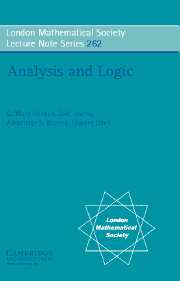Book contents
- Frontmatter
- Contents
- Preface
- Introduction
- Part One: Ultraproducts in Analysis
- Actions of Polish Groups and Classification Problems
- On Subspaces, Asymptotic Structure, and Distortion of Banach Spaces; Connections with Logic
- 1 Introduction
- 2 Background material: The 60's and 70's
- 3 The unconditional basic sequence problem and connections with distortion
- 4 Gowers' dichotomy: A block Ramsey Theorem
- 5 Distortion
- 6 Asymptotic structure
- 7 Ordinal Indices
- 8 The homogeneous Banach space problem
- 9 Concluding remarks
- References
1 - Introduction
Published online by Cambridge University Press: 05 May 2013
- Frontmatter
- Contents
- Preface
- Introduction
- Part One: Ultraproducts in Analysis
- Actions of Polish Groups and Classification Problems
- On Subspaces, Asymptotic Structure, and Distortion of Banach Spaces; Connections with Logic
- 1 Introduction
- 2 Background material: The 60's and 70's
- 3 The unconditional basic sequence problem and connections with distortion
- 4 Gowers' dichotomy: A block Ramsey Theorem
- 5 Distortion
- 6 Asymptotic structure
- 7 Ordinal Indices
- 8 The homogeneous Banach space problem
- 9 Concluding remarks
- References
Summary
The most outstanding problems in the theory of infinite dimensional Banach spaces, those that were central to the study of the general structure of a Banach space, finally yielded their secrets in the 1990's. In this survey we shall discuss these problems and their solutions and more. For many years researchers have been aware of deep connections between both the theorems and ideas of logic and set theory and Banach space theory. We shall try to illuminate these connections as well.
For example the ideas of Ramsey theory played a key role in H. Rosenthal's magnificent l1-theorem in 1974 [R1]. But there is also a less direct connection with the Banach space question as to whether or not separable infinite dimensional Hilbert space, l2, is distortable. This is equivalent to the following approximate Ramsey problem. Let Sl2 = {x ∈ l2: ∥x∥ = 1} be the unit sphere of l2. Finitely color the sphere by colors C1,…, Ck and let ε > 0. Does there exist an i0 and an infinite dimensional closed linear subspace X of l2 so that the unit sphere of X, SX, is a subset of (Ci0)ε = {y ∈ Sl2 : ∥y − x∥ < ε for some x ∈ Ci0}? It suffices to let (ei) be an orthonormal basis for l2 and confine the search to block subspaces — those spanned by block bases of (ei) (these terms are defined precisely below).
- Type
- Chapter
- Information
- Analysis and Logic , pp. 191 - 193Publisher: Cambridge University PressPrint publication year: 2003



